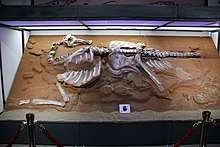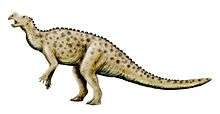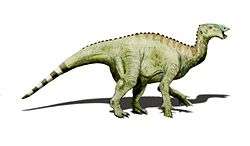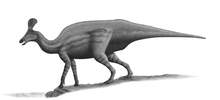Bactrosaurus
Bactrosaurus (/ˌbæktroʊˈsɔːrəs/; meaning "Club lizard," "baktron" = club + sauros = lizard) is a genus of herbivorous dinosaur that lived in Asia during the Late Cretaceous, about 96 million years ago, though some Bactrosaurus fossils have been dated back to 90 mya. The position Bactrosaurus occupies in the Cretaceous makes it one of the earliest known hadrosauroids, and although it is not known from a full skeleton, Bactrosaurus is one of the best known of these forms of hadrosaurs predecessors.
| Bactrosaurus | |
|---|---|
 | |
| Skeleton on display at the Central Museum of Mongolian Dinosaurs, Ulaanbaatar | |
| Scientific classification | |
| Kingdom: | Animalia |
| Phylum: | Chordata |
| Clade: | Dinosauria |
| Order: | †Ornithischia |
| Suborder: | †Ornithopoda |
| Clade: | †Hadrosauromorpha |
| Genus: | †Bactrosaurus Gilmore, 1933 |
| Type species | |
| †Bactrosaurus johnsoni Gilmore, 1933 | |
| Species | |
| |
Discovery
The first Bactrosaurus remains recovered from the Iren Dabasu Formation in the Gobi Desert of China were composed of partial skeletons of six individual B. johnsoni. The specimens collected appear to come from a variety of age groups, from individuals that may be hatchlings to full-sized adults. The fossils were described in 1933 by Charles W. Gilmore, who named the new animal Bactrosaurus, or "club lizard", in reference to the large club-shaped neural spines projecting from some of the vertebrae.[1] The Iren Dabasu Formation has been dated to the Cenomanian stage, around 95.8 ± 6.2 million years ago.[2]
No complete remains have yet to be uncovered, but Bactrosaurus is still better known than most of the early hadrosaurs. Known parts of the anatomy of Bactrosaurus include the limbs, pelvis, and most of the skull (although the crest is notably absent).[3]
"Bakesaurus" is an informal name based on a maxilla from China assigned to Bactrosaurus in 2001.[4] The nomen nudum was created and pictured a Chinese-language book by Zhou (2005).[5]
Description

A typical Bactrosaurus would have been 6.2 m (20 ft) long and weighed 1.2 to 3.6 t (1,200 to 3,600 kg).[6][7] It was an early relative of Lambeosaurus, perhaps a predecessor, as it shows a number of iguanodont-like features, including three stacked teeth for each visible tooth, small maxillary teeth, and an unusually powerful build for a hadrosaur. It shows features intermediate between those of the two main hadrosaurid groups, and may represent an ancestral form that evolved from an earlier iguanodontid dinosaur.[3][8] Its femur measured 80 centimetres (2.6 ft) long.[1]
Bactrosaurus was originally described as lacking a crest, which would be typical for an iguanodont, but anomalously primitive for a lambeosaurine like itself. However subsequent study of Bactrosaurus remains uncovered pieces of what appear to be the base of an incompletely preserved crest.[3]
Paleobiology
In 2003, evidence of tumors, including hemangiomas, desmoplastic fibroma, metastatic cancer, and osteoblastoma was discovered in fossilized Bactrosaurus skeletons. Rothschild et al. tested dinosaur vertebrae for tumors using computerized tomography and fluoroscope screening. Several other hadrosaurids, including Brachylophosaurus, Gilmoreosaurus, and Edmontosaurus, also tested positive. Although more than 10,000 fossils were examined in this manner, the tumors were limited to Bactrosaurus and closely related genera. The tumors may have been caused by environmental factors or genetic propensity.[9]
See also
References
- Gilmore, C. W. (1933). "On the dinosaurian fauna of the Iren Dabasu Formation". Bulletin of the American Museum of Natural History. 67 (2): 23–78. hdl:2246/355.
- Guo, Z. X.; Shi, Y. P.; Yang, Y. T.; Jiang, S. Q.; Li, L. B.; Zhao, Z. G. (2018). "Inversion of the Erlian Basin (NE China) in the early Late Cretaceous: Implications for the collision of the Okhotomorsk Block with East Asia" (PDF). Journal of Asian Earth Sciences. 154: 49–66. doi:10.1016/j.jseaes.2017.12.007.
- "Bactrosaurus." In: Dodson, Peter & Britt, Brooks & Carpenter, Kenneth & Forster, Catherine A. & Gillette, David D. & Norell, Mark A. & Olshevsky, George & Parrish, J. Michael & Weishampel, David B. The Age of Dinosaurs. Publications International, LTD. p. 131. ISBN 0-7853-0443-6.
- Li, Z. (2001). "Distribution, burying and classification of dinosaur fossils in Upper Cretaceous strata at Meipu Town, Yunxian County of Hubei Province". Hubei Geology & Mineral Resources. 15 (4): 25–31.
- Zhou, S.Q.D. (2005). The Dinosaur Egg Fossils in Nanyang, China. China University of Geosciences Press. pp. 1–145. ISBN 978-7-562-52033-7.
- Holtz, T. R.; Rey, L. V. (2007). Dinosaurs: The Most Complete, Up-to-Date Encyclopedia for Dinosaur Lovers of All Ages. Random House. ISBN 9780375824197.CS1 maint: date and year (link) Genus List for Holtz 2012 Weight Information
- Paul, G. S. (2016). The Princeton Field Guide to Dinosaurs (2nd ed.). Princeton, New Jersey: Princeton University Press. pp. 151−152. ISBN 9780691167664.
- Palmer, D., ed. (1999). The Marshall Illustrated Encyclopedia of Dinosaurs and Prehistoric Animals. London: Marshall Editions. p. 146. ISBN 1-84028-152-9.
- Rothschild, B. M.; Tanke, D. H.; Helbling II, M.; Martin, L. D. (2003). "Epidemiologic study of tumors in dinosaurs". Naturwissenschaften. 90 (11): 495–500. doi:10.1007/s00114-003-0473-9. PMID 14610645.







.jpg)